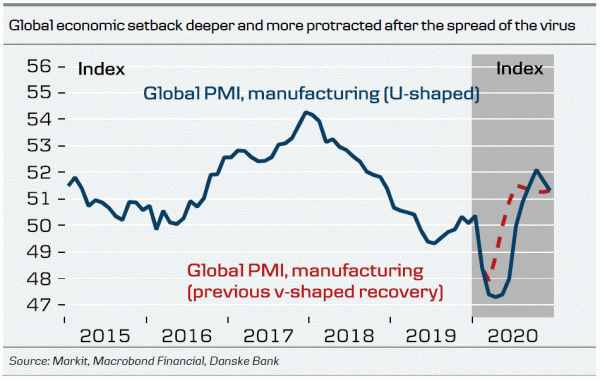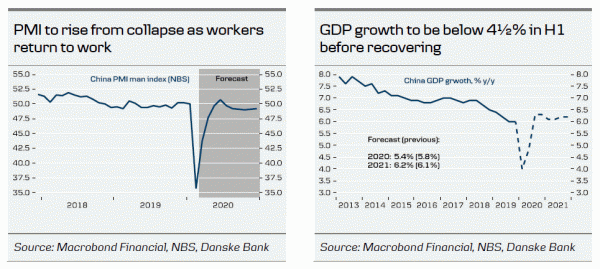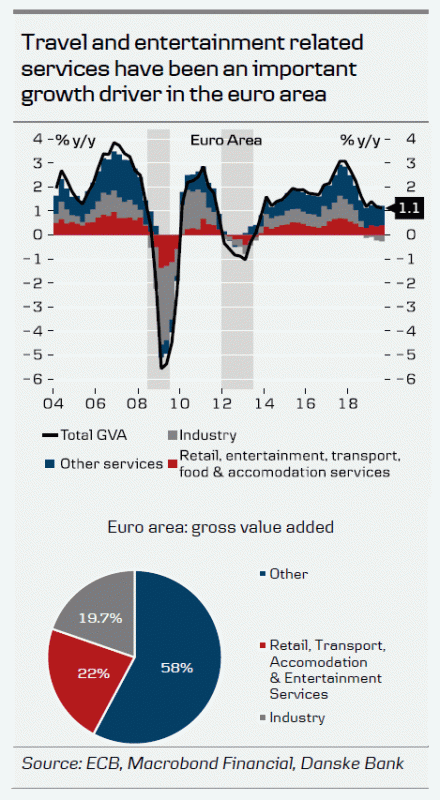- While the virus seems to be getting under control in China, the spread to Italy, South Korea, Iran and lately many other countries has triggered the risk scenario of a global pandemic from the coronavirus.
- This will hit the important service sectors globally in addition to global value chains, curtailing global growth well into Q2, before giving way to a recovery in H2 as the virus concerns abate.
- Instead of a V-shaped rebound, we now expect a U-recovery for the global economy. However, we do not expect an L-shaped scenario, where the global economy is stuck in recession throughout the year.
- A coordinated G7 policy response as well as swift individual central bank response (Fed cut its policy rate by 50bp yesterday together with the Australian central bank 25bp cut) will help smooth the hit to the global economy.
- In a downside scenario where the virus outbreak turns out to be much more severe, the hit to economic growth will be more severe and prolonged, even with a coordinated and forceful monetary and fiscal policy response.
The coronavirus becoming a global pandemic
The development in the spread of the coronavirus has taken a sharp turn for the worse over the past 10 days. While the situation looks better in China, the spread to Italy, South Korea, Iran and lately many other countries has triggered the risk scenario that the virus is becoming a global pandemic. Particularly concerning from an economic point of view is the contagion to other European countries, which is now following the same kind of exponential pattern that we saw in China in January. At the same time it has spread to more than 60 countries globally, and there is a clear risk we start to see a real exponential outbreak of the COVID-19 virus in the US as well
The political response in Europe has been less forceful than in China at a similar stage of the outbreak. For example, China locked down the city of Wuhan on 23 January, when there were fewer than 500 cases registered in the province of Hubei and a total of 17 deaths. Similar measures have not been seen in Europe at a level of more than 2,000 cases in Italy alone. The contagion could thus spread quite fast. The view in Europe seems more relaxed: that it is comparable to a tough flu with a bit higher mortality but that it cannot be contained or at least that it may not be worth paying a very high economic cost to try. This suggests that we should expect a lot higher numbers in Europe looking ahead.
Our baseline assumption is now that we will see a further contagion in the rest of Europe. We also expect it to spread to the US as it will be difficult for the US to keep it out with so many countries now being hit and many people from these countries travelling frequently to the US.
When we updated our global growth scenario in early February it was based on the assumption that the virus would be contained in China within 1-2 months but not spread further. We also highlighted two risk factors: 1) that China would see a new wave of contagion when people returned to work and 2) that the virus would start spreading outside of China. The second risk factor is now playing out. Fortunately we have not yet seen signs that China will have a new wave of contagion but it is still a risk that bears watching. The more countries outside China that are affected, the higher the risk that it returns to China and starts spreading again. This is not our baseline scenario, though.
The global economic outlook: U-shaped recovery more likely than L-shaped
The spreading of the virus has dashed hopes for a V-shaped recovery. Underpinning the V-shaped recovery scenario was the assumption that the virus would mainly hit the global supply chain and less so demand outside of China. Once the virus problems abated there and production was ramped up, the global economy would also recover fairly quickly.
However, the spreading of the virus to Europe, Asia, and potentially the US will curtail growth for longer than first assumed. Our new base-case assumes that the virus continues to be contained in China, but that it spreads further outside China, including more broadly in Europe outside Italy as well as to the US. In this scenario, virus concerns will weigh on the service sectors as people get more concerned about travelling, transportation, public events and shopping more generally. This will hurt demand in addition to the supply disruptions. The uncertainty posed by the virus will also hit investments. We see these concerns weighing on economic activity well into Q2. However, as the virus fears abate, we see production and demand returning, likely in late Q2 or early H2 20.
As a result, instead of V-shaped rebound, we think the world economy will go through a U-shaped recovery. This means a somewhat deeper fall in global PMI than envisaged in our V-shaped scenario, where we expected global PMI to drop from 50 to 48 and then subsequently rebound. In the U-shaped recovery scenario, global PMI may drop to 46 and the subsequent rise will be less pronounced (see chart on front page). The strong policy response by the Fed but also other central banks will limit some of the economic fallout from the virus shock.
We do not think that the global economy will fall into a recession (where unemployment starts to rise globally) in our base-case (although the risk is albeit larger than before the virus started to spread globally). This would become a risk if the virus becomes so pervasive that tight restrictions on movement of goods and people lead to significant curtailment of economic activity globally, and if fear takes the hold of consumers making them avoid restaurants, hotels, flights etc. as was the case in China. In such a scenario (our risk scenario, see below), the slump would be deeper and could lead to an L-shaped scenario in which the global economy goes into recession and stays there for most of 2020.
China: contagion slows, but downside risks to growth are rising
The spread of the virus has slowed down a lot in China over the past weeks and production is gradually ramped up again with people returning to work. The February PMI manufacturing collapsed completely but this was to be expected given the partial shutdown of production for a large part of February. We look for an increase in PMI already in March as production is bound to increase.
However, PMI currently mostly reflect the big supply-side disruption that happened when workers were forced to stay home. What will matter more for the overall outlook now, is how much of a recovery we see on the demand side. Several factors suggest we should expect demand growth to come back more gradually.
- The service sector will likely suffer for a while from people still staying home from cinemas, restaurants and hotels and limiting travel on aeroplanes and trains.
- We also expect investment growth to stay subdued for longer given the increased uncertainty about cash flows and a hit to exports from the global
- Contagion, not least to the euro area, where not least the Italian economy will suffer from the outbreak.
- Increased job uncertainty and wage cuts in some areas are set to lower income growth and keep the savings rate higher for a while. And with the global contagion this uncertainty is with us for a longer time. Hence, it will take longer for private consumption to return to ‘normal’ growth rates.
On top of this, we see a rising risk that the electronics sector could face supply-chain disruptions due to the rising spread of the COVID-19 virus to South Korea and Japan. Both countries are important suppliers of semi-conductors and other components for the Chinese electronics industry.
We now look for the economic weakness in China to drag out to include Q2 and part of the increase in Q3 is an effect of some ‘catch-up’ in production as inventories are worn down and some postponed business spending is coming through. We have lowered the GDP forecast for 2020 to 5.4% from 5.8% previously. In 2021 we expect growth to recover and have revised it slightly up to 6.2% from 6.1% as some of the ‘catch-up’ effect lasts into 2021.
We have factored easing of both monetary and fiscal easing through various channels such as moderate rate cuts, a cut in the corporate tax rate and more infrastructure spending. We also expected targeted measures to support the industries and regions hit the most.
Rising fears about Japan and supply chain from South Korea
The situation in Japan has worsened significantly recently. Q4 GDP ticked in much worse than expected. PMIs and trade figures point to no rebound in Q1. We now expect – 0.6% GDP growth in 2020, assuming a rebound in exports and private consumption in Q3. Big public gatherings are postponed or cancelled and schools will be closed until spring break at the end of March. The island of Hokkaido has declared a state of emergency over the pace of virus transmission, and urges residents to stay home. Hokkaido has 5.3 million residents and makes up only about 3% of the total economy. Over the weekend, PM Abe announced an additional USD2.5bn emergency package to support the economy funded by reserve government funds. Monday morning the BoJ bought a record amount of ETFs and injected emergency funds to banks.
The risk for Japan is that the spread of the virus is not contained in due time before the Olympics. That could trigger a cancellation or more likely perhaps significantly lower attendance at the games. Japan is counting on millions visiting the country during the Olympics for a much needed boost to demand. The Bank of Japan estimates the Olympics will contribute 1.5% of GDP in 2020. What already looks to be a difficult year could be a terrible one for the economy if the virus is not contained soon.
South Korea is the country apart from China that has seen the highest number of infected. It is not a big economy on a global scale but it is an important part of the global value chain with a large production of semiconductors such as microchips. South Korean manufacturing PMI declined modestly from 49.8 to 48.7 in February, but the drop was cushioned by an increase in delivery times, which is not a positive in this case. Quick trade data out of South Korea do not initially look to be affected by coronavirus in February but if you correct for the number of business days, semiconductor exports are actually down 7% y/y ( from 1% in January) – an early sign that the Korean link in the global value chain is negatively affected
Corona crisis morphs into a European demand shock
We have previously argued that the coronavirus outbreak will mainly affect Europe through its trade and industry links to China (i.e. via the supply side), while leaving domestic demand relatively unscathed. However, with the outbreak now spreading outside China and Italy the country with the highest number of COVID-19 infections globally after China and South Korea, the corona crisis has now taken on an added dimension and morphed into a demand shock for Europe as well in our view.
Italy – one of the euro area countries with the weakest economic backdrop in the first place – has found itself at the epicentre of the outbreak. Within a week the number of infections has shot up to over 2,000, taking both authorities and markets by surprise. On a positive note, containment efforts have been relatively swift, limiting the outbreak largely to two regions in Northern Italy, Veneto and Lombardy, which account for roughly 80% of the infections.
Still, we think it will be difficult for Italy avoid falling into technical recession in Q1 20. Veneto and Lombardy are part of the industrial and business heartland of Italy and account for around a third of GDP. Additionally, tourism and related services will take a severe hit in Q1 and to some degree also Q2. With service sector activity being the key factor that has kept the Italian economy from recession in 2019, it is not difficult to imagine the Q1 growth contraction to be even more pronounced than Q4’s -0.3pp.
On a wider European level, the COVID-19 situation remains fluid, with the number of new cases creeping up in neighbouring countries, though still on a small scale compared to Italy. However, with the arrival of the virus on Europe’s shores, the hit to industry activity will be more pronounced, as not only Asian but also local suppliers start to be affected by closed factories. Northern Italy is an important industrial hub, not least for the (already battered) car sector. The closedown of electronics manufacturer MTA based in Codogno is a good example of this. Its closure could lead to forced production shutdowns in European plants of Fiat Chrysler, Renault, BMW and Peugeot in the coming weeks due to supply shortages of essential parts.
Although the February business sentiment indicators were generally better than expected, with PMI manufacturing rising to a one year high at 49.2, it might turn out to be the infamous ‘calm before the storm’. Anecdotal evidence from industry representatives such as Germany’s BDI suggest that the full impact of Chinese lockdowns has not yet fully been felt by European companies as immediate breaks in supply chains have not occurred so far and firms were able to use their inventories to maintain production during February. In Germany, only 8% of intermediate goods are directly imported from China and hence, it is not surprising that the ‘trickle down effect’ on European production only materialises with a 1-2 month lag. However, a closer look at the PMIs spells trouble ahead, with the new export order sub-index falling back to 47.6 and supplier delivery delays increasing sharply in an early sign of supply chain issues. In light of this, we still see more downside for euro manufacturing PMI ahead in the coming months, despite production and sales in China gradually coming up to speed again (see chart).
Probably even more important than the industry supply disruptions will be the hit to European domestic demand and services. Tourism in particular will be affected, even beyond Italy’s borders. French interior minister Bruno Le Maire talked about tourist numbers in France to be down 30-40% in 2020. For many Southern European countries tourism related activity can account for 10-15% of GDP. However, while tourism is the most obvious candidate as people stay home and postpone their travel plans, other related sectors such as food, accommodation, entertainment and retail will also feel the heat.
Together these account for around a quarter of euro area gross value added (GVA) and have contributed 0.3-0.4pp to annual growth in recent quarters.
Gauging the exact economic impact at the current stage is difficult. But in our baseline scenario, where we expect the COVID-19 outbreak to remain largely centred on Italy, with border closures and quarantines avoided at a wider European level, we now see euro area growth in 2020 arriving at 0.5% (0.8% previously) and 0.4% for Germany (0.6% previously). Compared to our previous forecast we now envision a larger hit to tourism related services (5% of GVA) across Europe and a marked growth slowdown in Italy in Q1.
In a risk scenario where the virus spreads significantly to other European countries outside Italy with similar production closedowns and quarantine measures, we expect a technical recession to unfold in H1 on a wider European level. Sharp contractions in consumer spending as observed under the Financial and Eurozone Crises would be the result in our view leading to a pronounced technical recession in H1 20 (see chart).
However, while the severity of the economic hit is difficult to gauge, it is important to stress that we expect it to be a short-lived technical recession in H1 and not evolve into a protracted ‘full-fledged’ employment recession. Once the number of new infections abates as we have seen in China in recent days, people return to work and ‘normal’ social routines resume, a strong rebound in growth in Q3 could even compensate for some of the weakness in H1. Restocking of depleted inventories in the manufacturing sector as well as pent-up demand from consumers will be important drivers for this development in our view.
US is also set to be hit by coronavirus
With the recent spreading of the coronavirus outside of China, it is difficult not to expect it will become a problem in the US, which will extend into Q2. As a consequence, we are lowering our GDP growth forecasts for both Q1 and in particular Q2. While we think the Markit PMI service index exaggerated the weakness in the US economy before the coronavirus fears, the US economy was not exactly in great shape before the virus shock and private consumption has disappointed. Despite our downward revision of our US GDP growth forecast in the near-term, we do not see this as the trigger for a US recession. This is based on the assumption that things are stabilising and optimism rebounds eventually, which will lead to a rebound in private consumption and business investment growth in H2 20. That said, the longer it drags out, the higher the risk of an outright recession. One concern is that lower economic activity will translate into a liquidity crisis causing a credit event in the US, which may have severe consequences.
We expect US GDP growth to slow to 1.4% this year (from 1.7% previously) accelerating back to 2.0% next year (1.9% previously).
Policy response—pro-active central banks, reactive governments
Over the past week, policy makers have stepped up their response to the spreading of the virus and risk of severe damage to the global economy. Both monetary, fiscal and financial sector prudential measures are in play. The policy response seems both to have come at the national level but also through global coordination, such as the G7 conference call, underscoring the concern with which policymakers view the hit from the virus.
Fed and other major central banks with policy space react
So far central banks with policy space left have acted, with the Fed and the Australian central bank cutting policy rates by 50bp and 25bp respectively yesterday. We expect the Fed to follow with another 50bp cut over the spring as the virus spreads (see also our Fed Monitor, 3 March 2020). We also see a good chance that Bank of England will follow suit soon, maybe ahead of the scheduled meeting on 26 March (cutting by a likely 25bp followed by another 25bp at the March meeting). On Monday morning, the Bank of England said it will take all needed steps to protect the economy and Carney stated yesterday that the BoE has room to cut by 50bp. At the time of writing, investors have priced in 75% of a rate cut in March.
The question is of course what central banks can really do to offset a negative demand shock stemming from a virus outbreak, but there may still be positive side-effects. If people are afraid of getting sick and staying home, the level of interest rates is probably not very important and conventional monetary policy is impotent. However, there are three very important channels, in our view. The first is to support financial market risk sentiment. A market collapse amid a virus outbreak is probably the last thing you want. The second is that lower interest rates mean that when things begin to look brighter again, the lower interest rates support a stronger growth rebound. The third is to make sure there is enough liquidity in the system. A very negative event would be if the virus outbreak turns into a liquidity crisis, where companies run out of cash and hence cannot live up to their loan obligations.
ECB reluctant to grant markets’ wishes
Despite markets now pricing a 50% probability of a 10bp rate cut already coming at the March meeting, ECB policymakers have so far been reluctant to validate markets’ calls for more easing. In fact Slovak governing council member tweeted that ‘panic and overreaction could cost us a lot’. So far the communication has centred on the ECB’s data driven reaction function, i.e. GC members have indicated a readiness to act and adjust all instruments as needed, but want to see the impact on the data first. More specifically, Lagarde’s statement on Monday night, suggest a targeted approach to potential impaired sectors of the economy. Hence, in our base case for a temporary slowdown in euro area growth in H1 20 as outlined above, we expect the ECB to stay put and wait for additional data before potentially taking any stimulating measures. As long as policymakers perceive the coronavirus as a short-term hit to the economy, a wait-and-see approach will prevail in the Governing Council in our view, not least amid the ongoing reversal rate discussion (i.e. can the ECB cut rates further without hampering credit creation?). One area where we expect more ECB action already in our baseline scenario is in terms of additional liquidity measures (i.e. bilateral swap lines with other central banks) as part of a coordinated G7central bank response and / or liquidity facilities of 6m-12m maturity to ensure banks bridge finance to the SMEs.
Bank of Japan also expected to stay on hold
The Bank of Japan has already committed to provide ample liquidity to the market as signalled last Friday and this Monday. The BoJ is now monitoring the situation and waiting to see how temporary it is. If the spread of the virus is contained and we get a recovery sometime during Q2, we expect that the BoJ will stay on hold. Within the current policy framework, there is a limit to what more they can do. If risk-off momentum continues the yen could come under severe pressure. A 10bp rate cut could be inevitable in an attempt to take some of the pressure off but it is certain the BoJ would prefer not to have to cut rates as negative rates are already weighing on the profitability of regional banks. If a more prolonged recession hits the economy, they can turn up JGB and ETF-purchases, at least for a while. However, they will have to consider the scope of digging in to other assets as well, as they already own the majority of both markets.
Fiscal policy response: modest and reactive in our base-case
Governments’ responses are likely to focus on alleviating the temporary disruptions to the economy from the virus, rather than major fiscal expansion in our base case.
In the EU, a wider European fiscal response does not yet seem around the corner. ECFIN Commissioner Paolo Gentiloni warned that the virus posed a material downside risk to European growth, but stressed the Commission would refrain from an assessment or serious forecast at the current stage, instead waiting for its spring forecast round due in April. With an ‘official’ EU assessment of the economic impact absent, a coordinated and sizable fiscal easing package out of Brussels seems unlikely in our view. Instead, the hope will rest on measures enacted by individual member states, both in terms of preventive measures to stem/contain the outbreak, but also ex post emergency support measures for consumers and companies.
Italian authorities are already working on an emergency package worth EUR3.6bn including tax relief and financial support for companies in virus hit regions through suspended mortgage and local tax payments. The German government is currently drawing up a contingency plan with similar support measures, if the economy is hit materially by the coronavirus repercussions. Additionally, talks about tweaks to the debt brake have been stepped up in the finance ministry, although a political majority for such changes is still not in sight.
While money at the EU level is scarce – as amply illustrated by the ongoing EU budget discussions – Brussels could support member states efforts indirectly by granting flexibility on temporary budget rule deviations. However, overall we expect the fiscal policy response more to be of a reactive rather than proactive nature, with individual country measures stepped up as the crisis spreads/progresses.
It is difficult to see a fiscal policy response in the US, in particular taking the US election into account. The situation needs to worsen significantly for the two parties to agree on stimuli measures, in our view. A smaller emergency spending bill amounting to USD7-8bn is being prepared.
In Japan, with the limits to the BoJ, fiscal policy will continue to play an important role in a crisis response. On Tuesday morning, PM Abe voiced his readiness to increase fiscal spending even further if necessary.
Finally, we expect central banks, governments and bank regulatory authorities to implement measures that can help banks support companies facing temporary liquidity needs and problems repaying their loans. This could include temporary regulatory forbearance for banks on capital and liquidity requirements.
Downside risk scenario: a technical global recession on the cards
In a scenario where the virus outbreak turns out to be much more serious than expected in Europe, Asia and also the US, the hit to economic growth will be much more severe than in our baseline. In such a downside scenario, the virus becomes so prevalent in western and Asian countries, leading to harsh travel bans and temporary closure of companies and shops.
In such a scenario, financial stress will rise considerably, notably in lower-rated corporate debt and highly leveraged loan funds, due to the shock to income and higher funding costs. Such financial stress would lead to financial losses among banks and the broader financial sector, risking negative feedback into the real economy.
We see a heightened risk of a technical but rather deep global recession in Q2 and Q3 as a result. The hit to economic activity in the euro area will reduce GDP growth to -0.1% in 2020. We still see global growth recovering but the recovery will take longer than in our base-case scenario, stretching into late 2020 (L-shaped recovery). We do not expect a lasting recession though, with policy support and demand rebounding at some stage.
As a response to the risk of deep downturn we expect a forceful policy response from both central banks and governments and global financial institutions and organisations. The most important monetary policy response will be from the Fed, which has different options for providing liquidity to the economy. First it would likely resort to temporary overnight and term repo operation against US Treasuries and mortgage-backed securities like those the Fed has conducted since last autumn. We also think the Fed would cut the Fed funds rate close to 0.00%, while also resorting to quantitative easing, buying US Treasuries across the curve and likely mortgage-backed securities, depending on the state of the mortgage market. If credit markets freeze or certain sectors of the economy experience limited access to credit, the Fed has the option of bypassing banks and lending directly to the real economy against collateral with appropriate haircuts via the provisions of section 13(3) of the Federal Reserve act.
In a risk scenario, where the euro area is heading into technical recession, we expect the ECB to come with a ‘small’ easing package in the form of a 10bp deposit rate cut, increased QE purchase volume (EUR40bn/month) and extension of TLTRO3 take up beyond March 2021. If needed, such a package could already come at the April meeting in our view



























